|
1877
|
Walzenphonograph von
Thomas Alva Edison:
erster notwendiger Vorläufer für das Konzept der Musikbox "Musikhören
nach Geldeinwurf". |
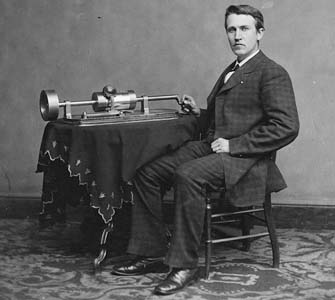 |
Cylinder phonograph
by Thomas Alva Edison: First milestone for the concept of the
jukebox "listening to music after inserting a coin in a slot". |
|
1887 / 1888 |
Zweiter notwendiger
Vorläufer für das Konzept der Musikbox "Musikhören nach
Geldeinwurf": die erste Schallplatte (aus Zink) von Emile Berliner
(geb. in Hannover, 1870 in die USA ausgewandert, gest.
3.8.1929 in Washington):
9/1887 reicht Berliner das Patent sowohl für das
Grammophone als auch die Schallplatte ein.
Unter dem Label "His Master's
Voice" mit dem Markenzeichen "Nipper", der Foxterrier,
der in den Schalltrichter eines Phonographen schaut,
vertreibt er seine Schallplatten und Grammophone. |
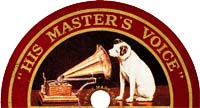 |
Second milestone for the concept of the jukebox
"listening to music after inserting a coin in a slot": Record-disc by
Emile Berliner (born in Hannover, Germany, immigrated in
USA in 1870, died 08/03/1929 in Washington).
In 9/1887 a patent for the phonograph and the record disk was
applied for.
Under the label "His Mater's Voice" with the trademark "Nipper",
the foxterrier who looks into the horn of the phonograph,
Berliner sells his phonographs and records. |
|
05/1888 |
Charles A. Randall reicht sein Patent für das "Automatic Pariophone"
ein: münzbetätigtes Gerät zum Aufzeichnen und
Wiedergeben von Stimme und Geräusch für Schallplatten und Walzen
mit Elektromotor; vermutlich nie gebaut.
Bewilligung: 5/1889
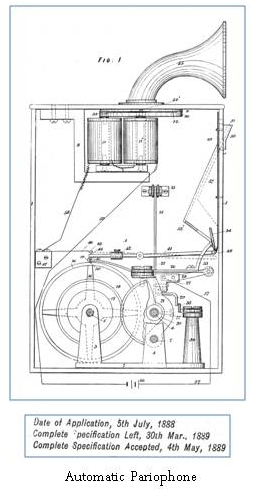
|

Zeitleiste Charles A Randall
Timeline Charles A. Randall
&

Biographie Charles A. Randall
Biography Charles A. Randall
by Gert Almind
|
Charles A. Randall
applies a patent for his "Automatic Pariophone": A coin-operated
instrument to record and reproduce speech and other sounds on
records and cylinders with electrical motor; probably never
built.
Granted: 5/1889
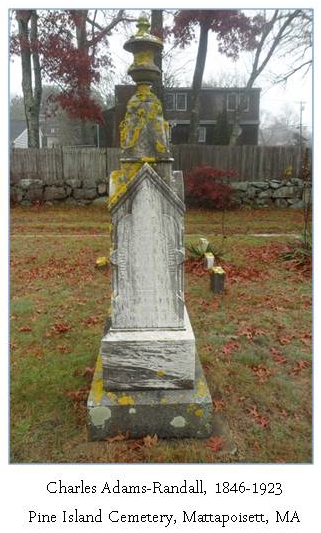 |
|
23.11.1889 |
Louis T. Glass (1845 - 1924) stellt den ersten münzbetätigten Phonographen im
Palais Royal Restaurant in San Francisco vor. An den sog.
Hörschläuchen waren so etwas wie Ohrhörer angebracht.
Sein Geschäftspartner war William S. Arnold (geb. 1851 in
Kanada, US Bürger in 1882, gest. 1908 in Kalifornien).
Besitzer des Palais Royal: Frederic Mergenthaler (geb. 1840 in
Straßburg (FR), gest. 1902 in Kalifornien).
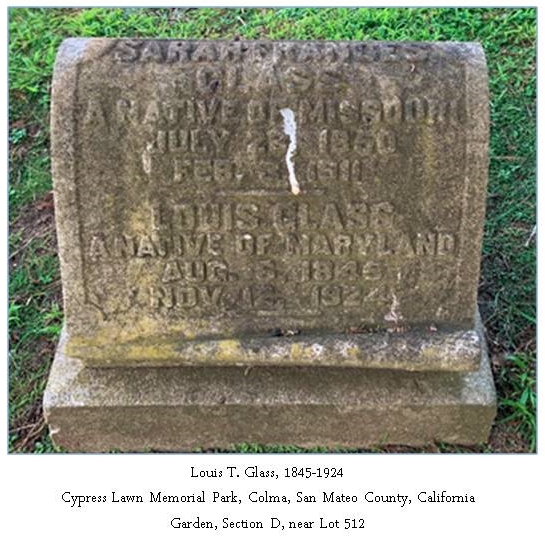 |
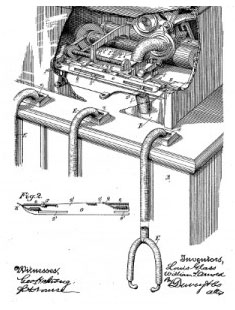
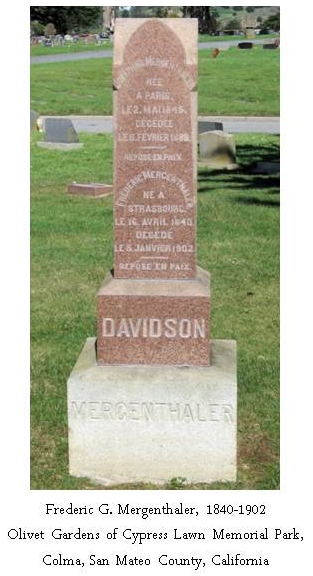 |
Louis T. Glass
(1845 - 1902) presents the first coin operated phonograph in the Palais Royal
Restaurant in San Francisco. The "Hearing-Tubes"
had a kind of headsets for listening.
His business associate was
William S. Arnold (geb. 1851 in
Kanada, US Bürger in 1882, gest. 1908 in California).
Owner of the Palais Royal:
Frederic Mergenthaler (born 1840 in
Strassbourg (FR), died in Califormia in 1902).
.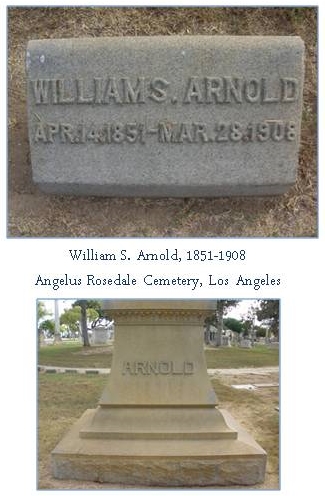 |
|
1904 |
Die
Deutsche Grammophon AG (gegründet 1898 in Hannover, Gründer
Emile und Joseph Berliner), stellt den "Selbstkassierender
Sprechapparat mit selbsttätiger Plattenförderung" vor -
bekannt als Automat IV - mit Nadelwechsler für sechs und zwölf
Schallplatten |
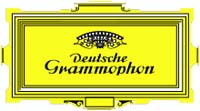 |
Deutsche Grammophon
AG (founded 1898 in Hannover, Germany, by Emile and Joseph
Berliner), presents its "Grammophone Record Changer Automat
IV".
It includes an automatic needle changer and is made for six
resp. twelve records. |
|
1904 |
Julius Wellner (geb. 25.4.1869 in
Österreich-Ungarn, gest. 1917 in Philadelphia, USA) - Gründer der Perfection Music-Boxes Co., reicht 1903 ein Patent für ein
Gramophone mit Nadelwechsler ein. Eingetragen im August 1904 mit
der Nummer 766,651.
 Julius
Wellner
Julius
Wellner |
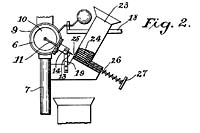 |
Julius Wellner (born 4/25/1869 in
Austria-Hungary, died in Philadelphia, USA in 1917) - founder of
the Perfection Music-Boxes Co., applies a patent reicht 1903 for
a sound reproducing apparatus with automatic needle changer in
1903. Granted with number 766,651 in August 1904.
 Julius
Wellner
Julius
Wellner |
|
1906 |
Gabel stellt die "Automatic Entertainer" vor: 24 Wahlen,
automatischer Nadelwechsler und
Trichter zur Schallverstärkung, Durchmesser 40". |
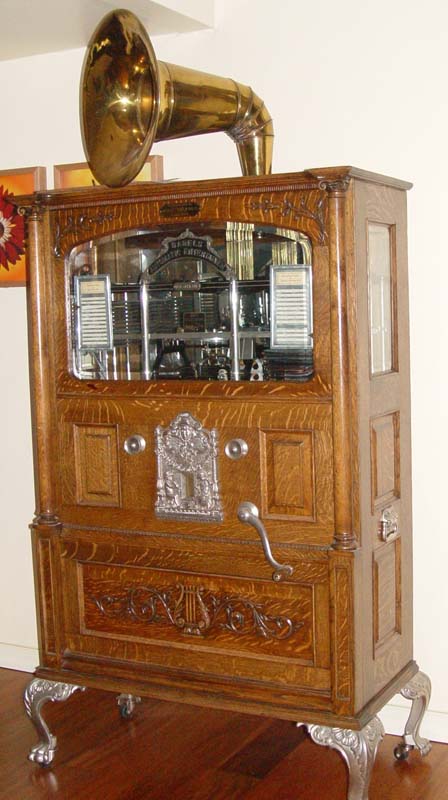 |
Gabel presents the
"Automatic Entertainer" - 24 selections, automatic
needle changer, and a large 40" horn on
top. |
|
1926/27 |
Die elektrische Verstärkung des Tons
kommt auf und ermöglicht so eine bessere Klangwiedergabe. |
|
The electrical
amplified sound is invented and makes a better sound
reproduction possible. |
|
1927 |
Erste Modelle mit elektrischen Verstärkern werden vorgestellt.
AMIs "National Automatic Selective Phonograph" wird meistens als
erste Musikbox bezeichnet.
Weitere Modelle vorgestellt 1927: Seeburg's "Melotone" und
Western Electric Piano Company's "Selectrophone" |
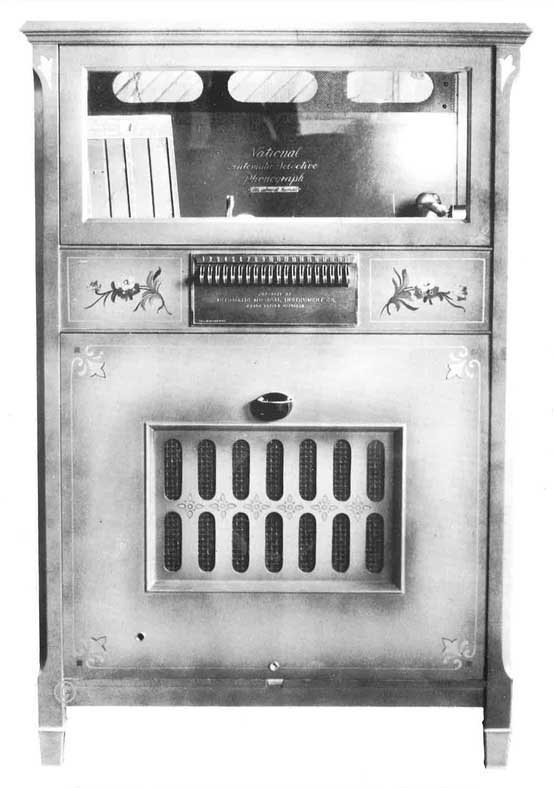 |
First models with
electrical amplifier are presented.
AMIs "National Automatic Selective Phonograph" is called the
first "Automatic Phonograph". Other models presented the same
year:
Seeburg's "Melotone" and Western Electric Piano Company's
"Selectrophone" |
|
1930er Jahre |
Die Gehäuse sind hölzern und sehen eher nach 'Möbeln' aus; Art
Deco Elemente sind sichtbar.
Wurlitzer präsentiert 1933 ihr erstes Modell (Debutante),
Rock-Ola erst 1935 (Multi-Selector) |
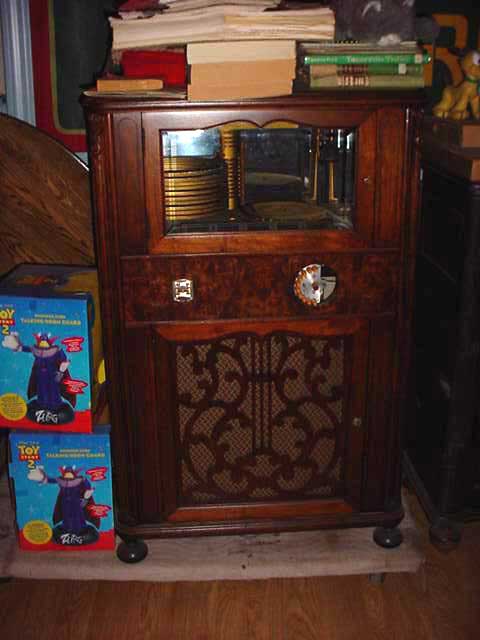 |
The cabinets are
wooden and are more furniture-like; Art-Deco elements are
typical.
Wurlitzer presents it first model (Debutante) in 1933, and Rock-Ola
model Multi-Selector in 1935. |
|
1934 |
Nach bisheriger Kenntnis baut Max Grabs (Deutschland) die erste
Kombination aus Fernwähler und Musikbox, bei der Titel direkt
angewählt werden. Über den Selektor wird mittels einer Spule die
direkte Wahl ausgelöst. |
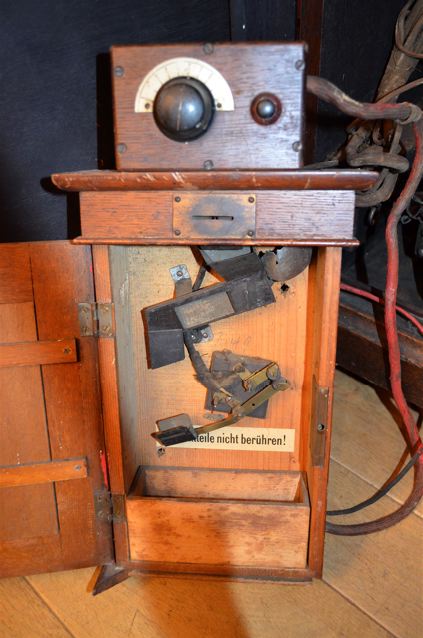 |
To be known so far Max Grabs (Germany)
produces the first combination of wallbox and jukebox in which
titles are selected directly. The selector triggers the
selection by means of a coil. |
|
1937 |
Gabel verwendet vermutlich mit dem Modell "Starlite" als erste
Firma beleuchtete Plastiks. |
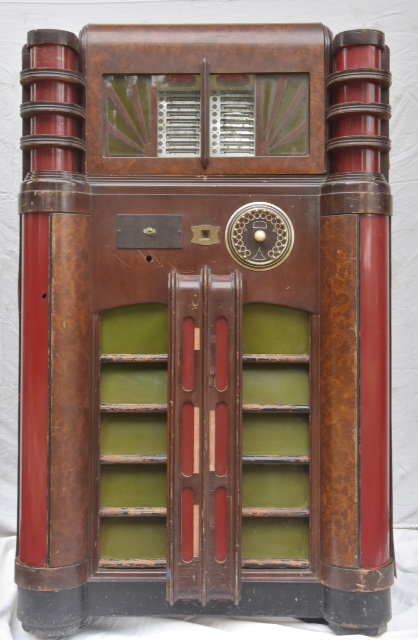 |
Gabel is the first
manufacturer using coloured illuminated plastics probably with
model "Starlite" in ca. 1937. |
|
1940 |
Erste Film-Musikboxen werden vorgestellt: Panoram (Mills),
Phonovison, Filmotone (Jersey Specialty Co.), Vis-O-Ton (Ampro
Co.). |
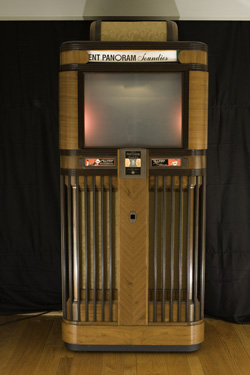 |
First film juekboxes get
introduced:
Panoram (Mills), Phonovison, Filmotone (Jersey Specialty Co.),
Vis-O-Ton (Ampro Co.).
|
|
1942 |
Die USA tritt in den Krieg ein; die Musikboxproduktion wird
aufgrund von Materialknappheit (Restriktionen) eingestellt und
die Firmen steigen in die Rüstungsindustrie ein |
|
The USA enter WW2;
the production of jukeboxes stops due to material restrictions
and the manufactureres step into the defence industry. |
|
1942-43 |
Die Plattenindustrie
verwendet mit der Werbung neuer Schallplatten den Begriff
"Coinograph". |
|
The record industry
uses the term "coinograph" when promoting new records. |
|
1940er Jahre |
Werden als das sog. "Golden Age" bezeichnet: farbige,
beleuchtete Plastiks kennzeichnen diese Modelle.
Das sog. "Telephone Line Music System" kommt auf: eine (zumeist
weibliche) Vermittlungsperson wurde durch ein Mikrofon
(Telefonleitung) angesprochen, die den gewünschten Titel
auflegte.
Modelle z.B. AMI Automatic Hostess, Shyver Multiphone |
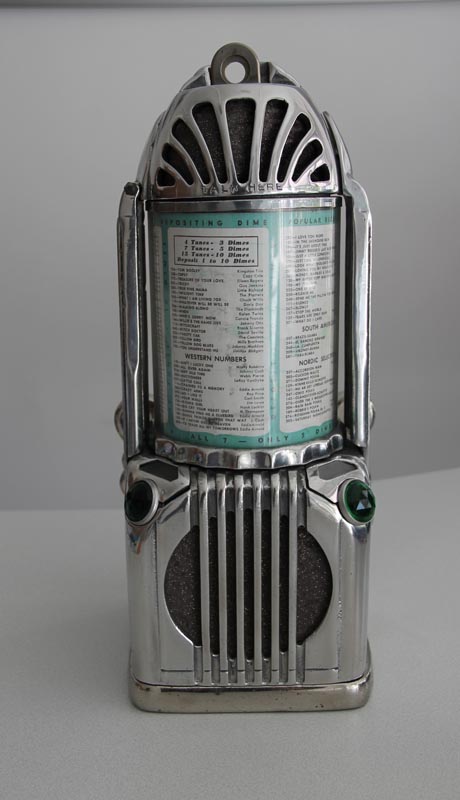 |
So called "Golden
Age": coloured illuminated plastics characterise these models;
the "Telephone Line Music System" is invented: a (mostly) female
operator was called through the microphone / telephone line who
then did play the selected song.
Modells e.g. AMI Automatic Hostess, Shyver Multiphone |
|
1946 |
Wurlitzer präsentiert die 1015, die zur legendärsten und
bekanntesten Musikbox aller Zeiten werden wird.
AMI übernimmt den Begriff "Jukebox" offiziell mit
Einführung der "A" |
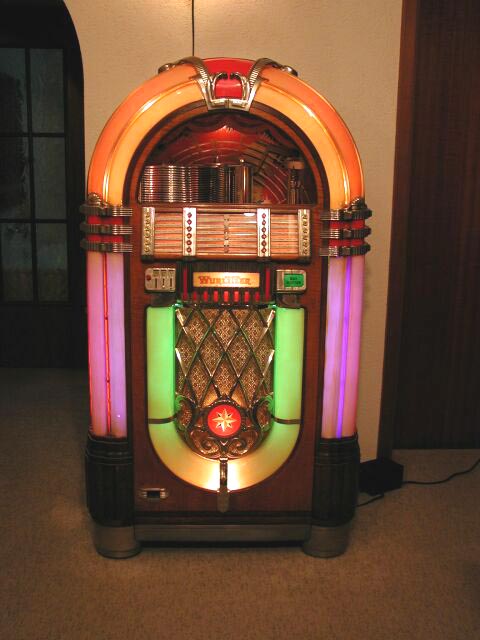 |
Wurlitzer presents
model 1015 which will become the most popular and legendary
jukebox of all time.
AMI uses the term "jukebox" officially for presenting their
model "A". |
|
1948 |
Seeburg stellt seinen ersten 200
Wahlen Mechanismus mit den "Industrial Commercial Music Center"
vor. Es können 25 und 30 cm Schellackplatten abgespielt werden.
Eine direkte Anwahl einzelner Titel wie in einer Musikbox
erfolgt jedoch nicht. |
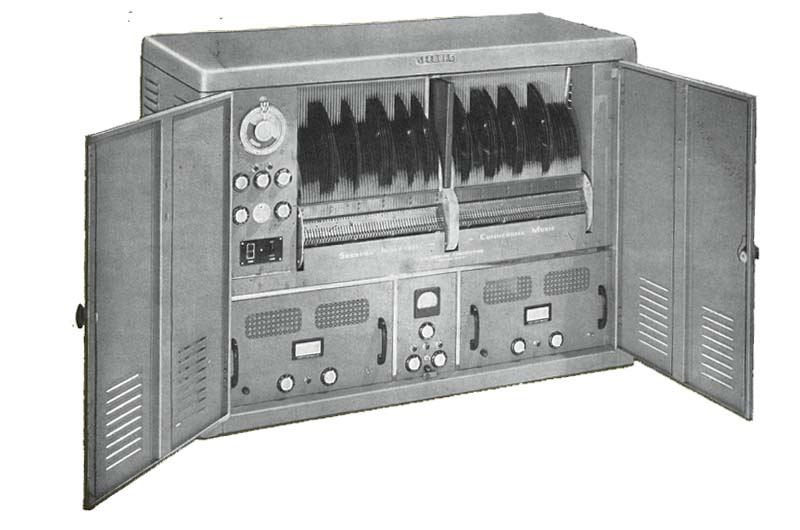 |
Seeburg presents the
first 200 selection mechanism with the
"Industrial Commercial Music Center". 10" and 12" shellac
records can be played. Though desired titels cannot be selected
directly. |
|
1949 |
Seeburg stellt die M100A vor, die 50 Schellackplatten beidseitig
abspielen kann. |
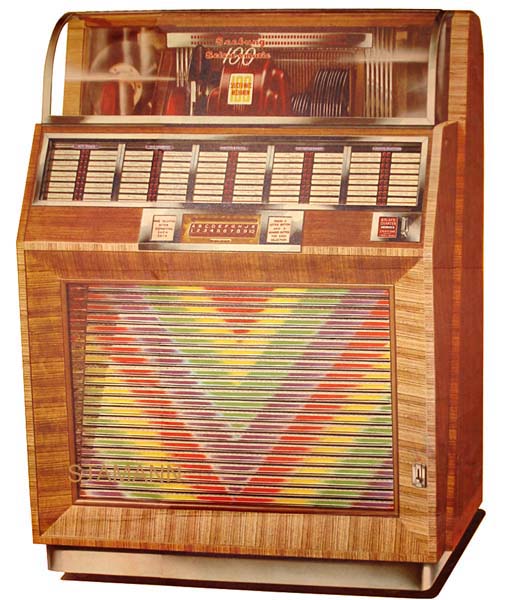 |
Seeburg presents
model M100A which plays 50 of 78 rpm records from both sides. |
|
1950 |
Seeburg stellt mit der M100B die erste Musikbox für 45 U/Min
vor. |
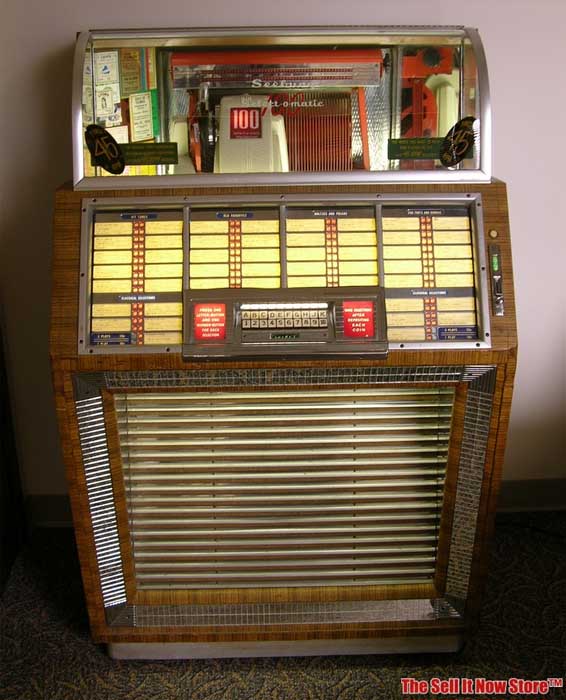 |
Seeburg presents
with model M100B the first 45 pm jukebox. |
|
1950er Jahre |
Sog. "Silver Age": Chrom und Glas
kennzeichnen das Design der US-Modelle, die Mechanik ist
sichtbar. |
|
So called "Silver
Age": Chrome and glass characterize the design of US models, the
mechanism is visible. |
|
1952-53 |
Deutschland produziert eigene Musikboxen: Wiegandt präsentiert
in 9/1952 eine Musikbox für 40 Wahlen, gefolgt von Tonomat's
"V102" für 102 Wahlmöglichkeiten in 2/1953 |
 |
Germany produces its
own jukeboxes:
Wiegandt presents a jukebox for 40 selections in 9/1952 followed
by Tonomat's "V102" in 2/1953. |
|
1955 |
Seeburg stellt die erste Musikbox mit 200 Wahlmöglichkeiten vor,
Modelle V200 und VL200 |
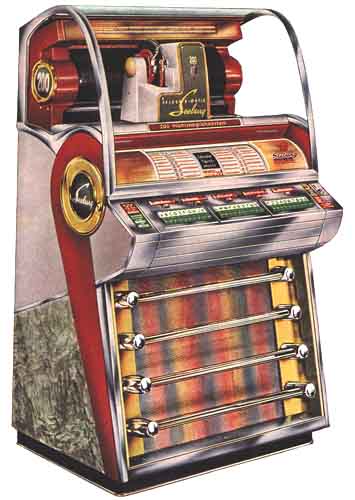 |
Seeburg presents the
first 200 selection jukebox - models V20 and VL 200. |
|
1956 |
Mit der
"Tonmaster", zunächst als "Tonmeister" bezeichnet", stellt
Wiegandt vermutlich die erste Wandmusikbox
vor. |
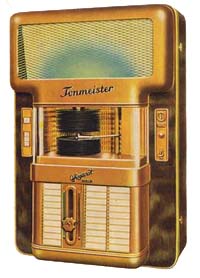 |
With model
"Tonmaster", first introduced as "Tonmeister", Wiegandt presents
most likely
the first wall mount jukebox. |
|
10/1958 |
Seeburg stellt die erste "Stereo-Jukebox" vor - Modelle 220 und
222, auch bekannt als "Channel" |
 |
Seeburg presents the
first stereo jukebox - models 220 and 222 - also known as
"Channel". |
|
1960er Jahre |
Das Design wird sachlicher, die Mechanik wird zunehmend durch
bedruckte, bunte Glasscheiben oder Titelhalter verdeckt;
sog. Intermix für 33 und 45 rpm wird beliebt, meistens für die
Albumwahl |
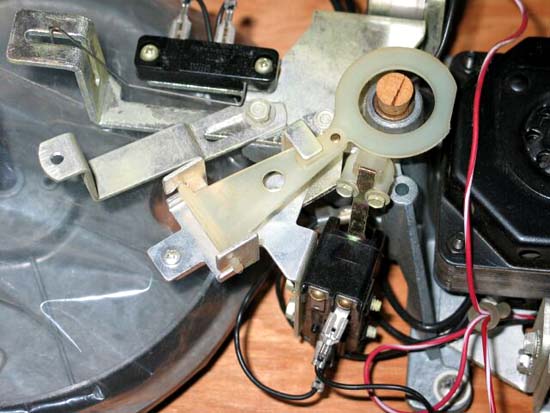 |
The design gets more
plain, the mechanism is hidden more and more by colourful
printed glasses or titel strip holders.
so called Intermix for 33 and 45 rpm records becomes popular,
often used as Album feature |
|
1970er Jahre |
In der 2. Hälfte des Jahrzehnts halten die ersten
computergestützten Musikboxen Einzug |
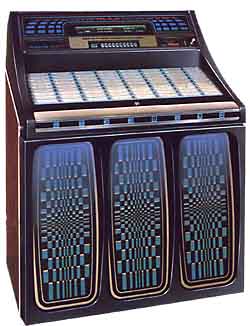 |
The first
computerized jukeboxes are invented in the second half of this
decade. |
|
1984 |
Nachdem Film-Musikboxen bereits 1940 und in
den 1960er Jahren verwendet wurden, stellt AMI mit der R-88 V/MEC
ein Music-Video-Entertainment Center vor. Oben auf der Musikbox
wird ein Bildschirm platziert. Für einige Songs wird das
passende Video abgespielt. |
|
After film jukeboxes had been used in 1940
and in the 1960s already, AMI presents with R-88 V/MEC a
Music-Video-Entertainment Center. On top of the jukebox a TV
screen got placed and for some titles a video gets played. |
|
1986 |
AMI bietet sog. Combo-Jukeboxen an - bestückt mit Singles und
CDs - Modell R90;
Seeburg stellt die erste CD Jukebox vor - Modell SCD1
Die Deutsche Wurlitzer baut mit der "1015 One More Time" - kurz
OMT - das legendäre Modell 1015 von 1946 nach; zunächst nur für
Vinyl, dann auch für CDs (1987). Diese Box wird an den Erfolg
des Vorbildes anknüpfen. Das nostalgische Design der 1015 wird
danach auch von anderen Firmen wie Rock-Ola (resp. Antique
Apparatus), AMI, NSM und Seeburg verwendet. |
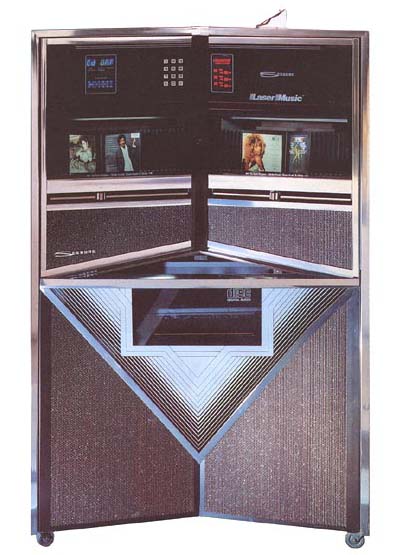 |
AMI offers so called
combo-jukeboxes - both for 45 rpm vinyl records and CDs
model R90.
Seeburg presents it's first CD jukebox - model SCD1.
The Deutsche Wurlitzer produces with model "1015 One More Time"
- aka OMT - a reproduction of the legendary model 1015 made in
1946; first for vinyl only, then for CDs as well (1987). This
model will be as successful as it's predecessor. the nostalgic
design of 1015 will be adapted by other manufacturers, too, like
Rock-Ola (resp. Antique Apparatus), AMI, NSM and Seeburg |
|
2000 ff. |
Digitale Jukeboxen mit DVD, Touchscreen, Download Funktionen,
iPod etc. halten Einzug. |
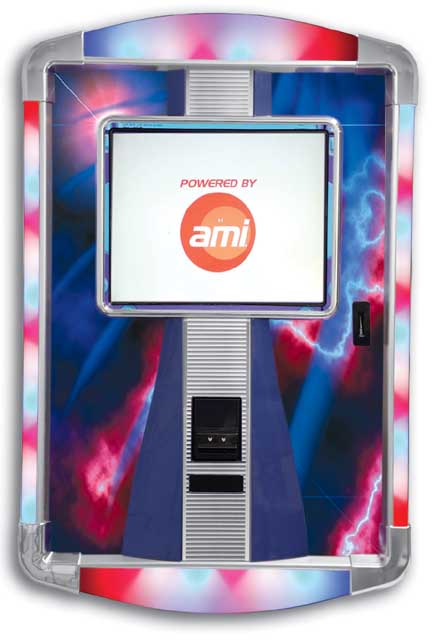 |
Digital jukeboxes
with DVD, touchscreen, download features, iPod etc. enter the
market. |

